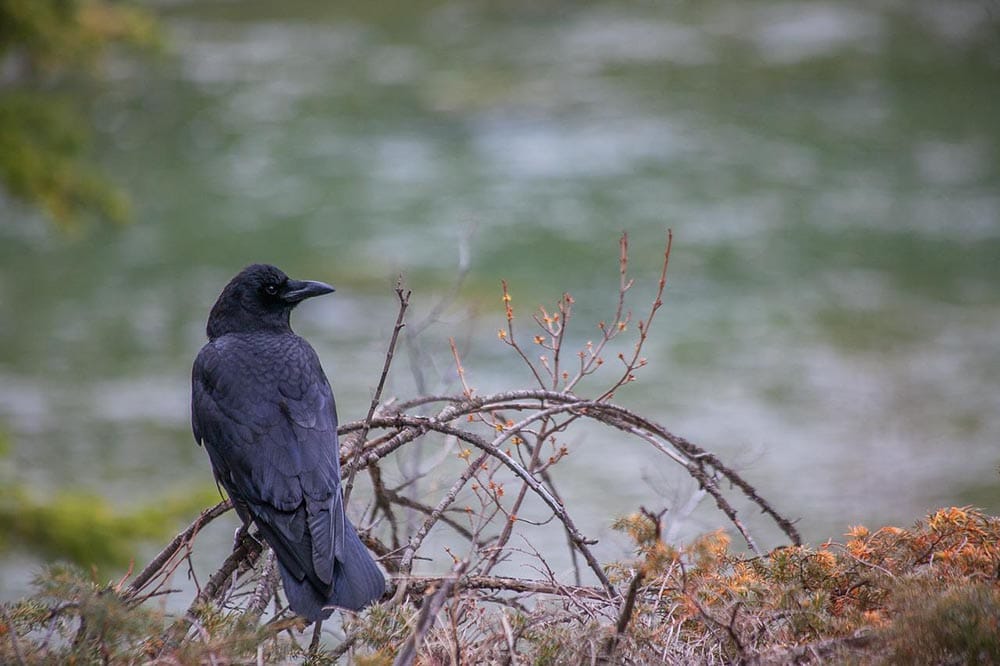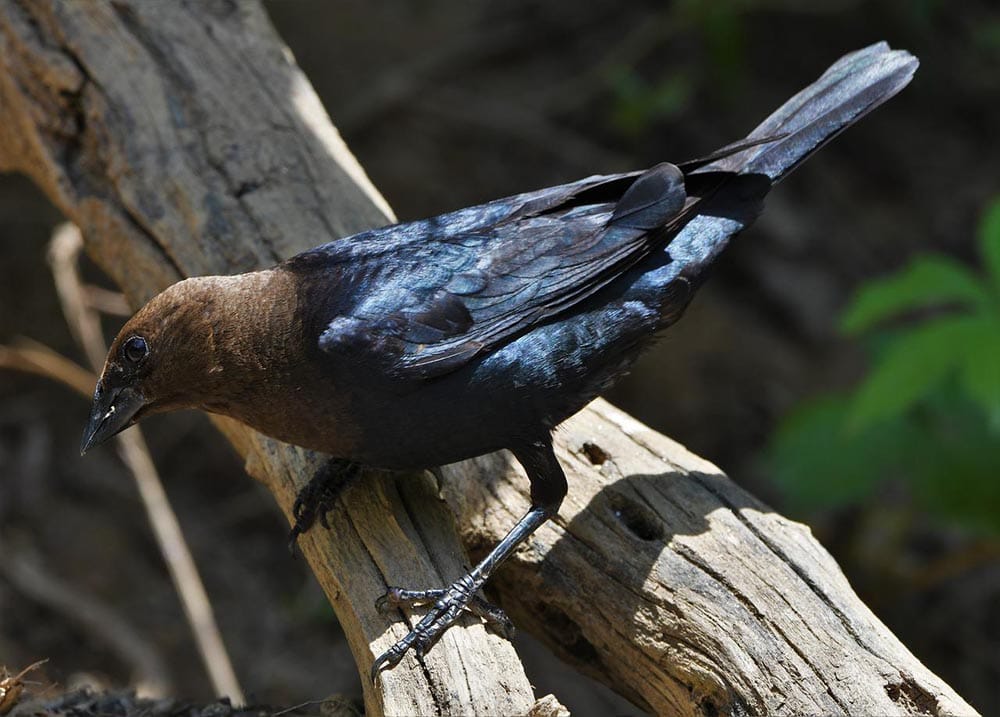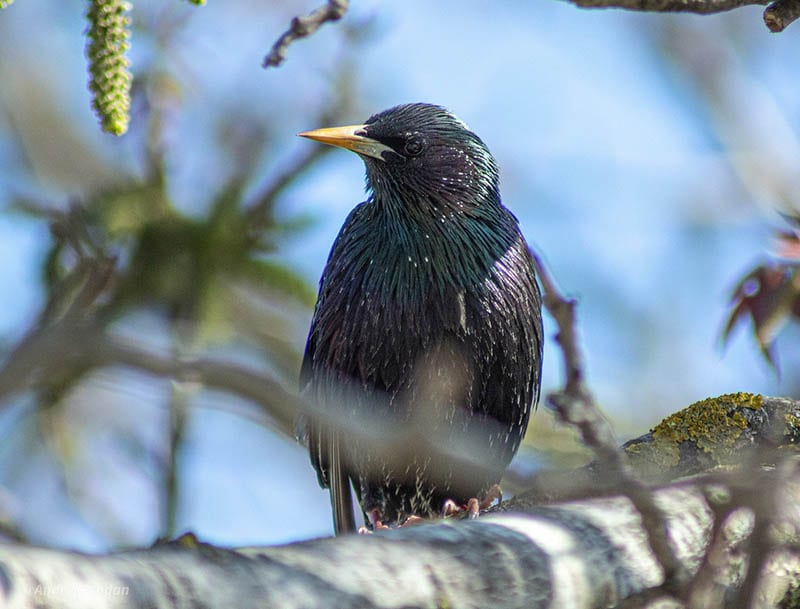10 Types of Black Birds in Alabama (With Pictures)
Last Updated on

Alabama is the 4th most biodiverse state in the United States, and 1st east of the Mississippi River. So, it should come as no surprise that there is a wide variety of plant and animal species that call Alabama home. That includes over 400 species of birds.
One of the most common types of birds you’ll see in Alabama, in rural backyards, city parks, and urban areas, are black birds. But how can you identify which type of black bird you’re looking at when you see one? That’s where we come in. Here are 10 varieties of black birds that live in the state.

The 10 Types of Black Birds in Alabama:
1. American Crow

| Scientific Name: | Corvus brachyrhynchos |
| Weight: | 11.2-21.9 oz. |
| Length: | 15.8-20.9 in. |
American crows are the largest species of black bird that you’ll see in Alabama. Crows are black all over; even their legs and beak are black. Crows live in pretty much any type of habitat and are very intelligent birds, some even hoarding “treasures” in their nests. But, many people consider them to be a nuisance because of their foraging habits, in which they will eat insects, seeds, and even garbage and other baby birds. Their loud cawing call is easily recognizable.
2. Boat-tailed Grackle

| Scientific Name: | Quiscalus major |
| Weight: | 3.3-8.4 oz. |
| Length: | 10.2-14.6 in. |
The boat-tailed grackle is not one of the most common black birds in Alabama, but they do exist in the southern part of the state, typically in coastal and marshy areas. These medium-sized black birds are smaller than crows, but like crows, many people consider them a nuisance because of their foraging habits. They’ll eat pretty much anything they can find. Males have glossy, black feathers that can look dark blue in certain light. Their boat-shaped tails make up half of their body length.
3. Bobolink

| Scientific Name: | Dolichonyx oryzivorus |
| Weight: | 1.0-2.0 oz. |
| Length: | 5.9-8.3 in. |
Bobolinks are odd-looking birds, and although they are considered black birds, they don’t have as much black coloring as other black birds do. Much of their face, stomach, and wings are black, but they also have a pale yellow cap and large patches of white on their wings. They don’t live in Alabama year-round, but rather they make a stop during their spring and fall migrations. You can see them most commonly in March and April in grasslands, marshes, and coastal areas. Bobolinks mostly forage for seeds. Unfortunately, the bobolink population is declining.
4. Brewer’s Blackbird

| Scientific Name: | Euphagus cyanocephalus |
| Weight: | 1.8-3.0 oz. |
| Length: | 7.9-9.8 in. |
Brewer’s blackbirds are only found in Alabama during the non-breeding season, particularly the winter months. Even though they live in pretty much any type of habitat, they can be hard to spot. It could be because they look quite similar to other species of blackbirds, being solid black with a greenish-blue tint in some lights. You may not know one if you see it. They nest in shrubs and find food mostly by foraging for seeds. Even though these birds are quite common, their population is also in steep decline.
5. Brown-headed Cowbird

| Scientific Name: | Molothrus ater |
| Weight: | 1.3-1.8 oz. |
| Length: | 7.3-8.7 in. |
As the name implies, the brown-headed cowbird only has a brown head. The rest of the bird is solid black. Brown-headed cowbirds live in Alabama year-round but are most commonly seen during the spring and summer months. These birds lay their eggs in the nests of other birds, even if there are already eggs inside, in lieu of building their own nests. They rely on other birds to hatch their eggs and raise the young. These birds live mostly in grasslands and open areas and forage on the ground for seeds.
6. Common Grackle

| Scientific Name: | Quiscalus quiscula |
| Weight: | 2.6-5.0 oz. |
| Length: | 11.0-13.4 in. |
The common grackle is one of the most common black birds that you’ll see in Alabama year-round. Many people may mistake them for crows, but common grackles are smaller than a crow and larger than a typical blackbird. You can also distinguish common grackles by their iridescent feathers. Males also have a dark blue head, but females are all-black. These birds live pretty much anywhere and can be a nuisance, as they will eat pretty much anything, including garbage.
7. European Starling

| Scientific Name: | Sturnus vulgaris |
| Weight: | 2.1-3.4 oz. |
| Length: | 7.9-9.1 in. |
European starlings are beautiful black birds, with iridescent feathers that can look purple, green, and blue in some lighting. Their feathers are flocked with specks of white. Despite their beautiful appearance, these birds can be annoying to some people because they fly in large flocks and can be quite noisy. European starlings tend to live in towns and neighborhoods and can also exhibit aggressive behavior. They’re cavity nesters and eat mostly insects.
8. Fish Crow

| Scientific Name: | Corvus ossifragus |
| Weight: | 6.9-11.6 oz. |
| Length: | 14.2-15.8 in. |
The fish crow looks almost identical to the American crow. The only difference between the two is that the fish crow is smaller, although you may not be able to tell the difference unless you put the two right next to each other. And while American crows live all over the state, fish crows only live in wetland areas in the southern half of the state. You can find them along river, lake, and ocean shorelines. And despite their name, fish crows don’t just eat fish but have similar foraging habits of the American crow. They’ll eat whatever they can find.
9. Red-winged Blackbird

| Scientific Name: | Agelaius phoeniceus |
| Weight: | 1.1-2.7 oz. |
| Length: | 6.7-9.1 in. |
The red-winged blackbird is very easy to spot compared to other black birds that you’ll see in Alabama. They are all black except for a red or reddish-orange patch on the top of its wings. They prefer living in marshy areas, grasslands, or large, open fields. You can also see them perching on lampposts and telephone wires. Red-winged blackbirds nest mostly in shrubs and males can be aggressive during the breeding season if something comes too close to their nest. These birds forage mostly for insects as their main food source.
10. Rusty Blackbird

| Scientific Name: | Euphagus carolinus |
| Weight: | 1.7-2.8 oz. |
| Length: | 8.3-9.8 in. |
The rusty blackbird is found in Alabama only in the non-breeding season as they migrate south. You’re most likely to see them in the state during November through March, but their population across North America is rapidly declining so they aren’t seen as much as they used to be. They’re called rusty blackbirds because although they are mostly black, they have rust-colored heads and rust-colored flocking on their backs and chest. These birds live primarily in forests while they’re in Alabama and eat mostly insects.

Final Thoughts
As you can see, there are several different varieties of black birds in Alabama, whether they be members of the blackbird family or just birds that have mostly black coloring. Most of these birds live in Alabama year-round, but some only live here during the non-breeding season. Regardless, we hope you found this guide helpful for identifying any type of black bird that you may see in Alabama in your backyard or elsewhere.
Featured Image Credit: Paul Reeves Photography, Shutterstock
About the Author Robert Sparks
Robert’s obsession with all things optical started early in life, when his optician father would bring home prototypes for Robert to play with. Nowadays, Robert is dedicated to helping others find the right optics for their needs. His hobbies include astronomy, astrophysics, and model building. Originally from Newark, NJ, he resides in Santa Fe, New Mexico, where the nighttime skies are filled with glittering stars.
Related Articles:
Monocular vs Telescope: Differences Explained (With Pictures)
10 Types of Hummingbirds in Arkansas (With Pictures)
8 Types of Hummingbirds in Nebraska (With Pictures)
5 Types of Hummingbirds in Idaho (With Pictures)
3 Types of Hummingbirds in Mississippi (With Pictures)
8 Types of Hummingbirds in Kansas (With Pictures)
5 Types of Hummingbirds in West Virginia (With Pictures)
5 Types of Hummingbirds in Ohio (With Pictures)
